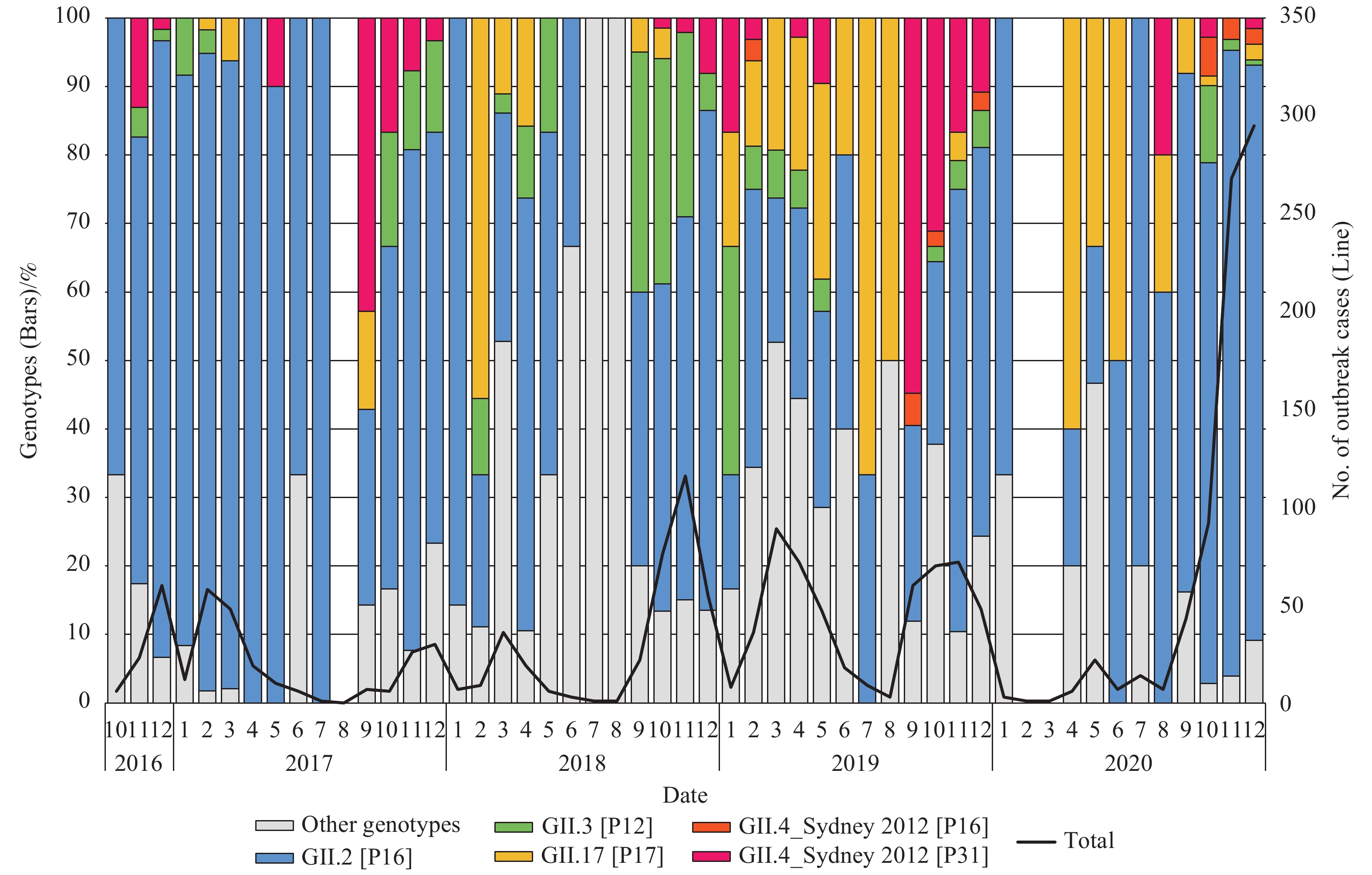2021 Vol. 3, No. 53
Human noroviruses are the leading cause of acute viral gastroenteritis (AGE) worldwide in all age groups. GII.4 strains have been the predominant genotype circulating globally over the last 2 decades and since 2012. GII.4 Sydney viruses have emerged and caused the majority of AGE outbreaks worldwide.
Data from norovirus outbreaks from the laboratory-based surveillance of norovirus outbreaks in China (CaliciNet China) between October 2016–December 2020 were analyzed.
During October 2016–December 2020, 1,954 norovirus outbreaks were reported, and positive fecal samples from 1,352 (69.19%) outbreaks were genotyped. GII.4 Sydney [P31] viruses accounted for 2.1% (October 2016–August 2017), 5.5% (September 2017–August 2018), 3.3% (September 2018–August 2018), 26.6% (September 2019–August 2020), and and 1.1% (September 2020–December 2020) of GII outbreaks, respectively. Compared to reference strains of GII.4 Sydney [P31] from 2012 to 2013, 7 amino acid mutations in epitopes[A (297, 372 and 373), B (333), E (414), and H (309 and 310)] and 1 in human histo-blood group antigens binding site at site II 372 were found by analyzing 9 GII.4 Sydney [P31] complete genomic sequences.
This report identified the genomic variation of GII.4 Sydney [P31] from CaliciNet China. Continued surveillance with prompt genotyping and genetic analysis is necessary to monitor the emergence of novel GII.4 variants.
With the expansion of human immunodeficiency virus (HIV) antiretroviral therapy (ART), HIV drug resistance is becoming more and more serious. This study describes the changing prevalence of HIV-1 subtypes and transmitted drug resistance (TDR) among newly diagnosed individuals in China, 2015 and 2018.
A total of 8,980 individuals in 2015 and 2018 from 31 provincial-level administrative divisions (PLADs) were enrolled in this study. Viral RNAs were amplified and sequenced using an in-house polymerase chain reaction (PCR) protocol. The Stanford HIV Drug Resistance Database (HIVdb) was used to predict susceptibility to 12 antiretroviral drugs.
The prevalence of TDR was not significantly increased over time. The prevalence of TDR was 3.8% and 4.4% in 2015 and 2018, respectively (P=0.13). The prevalence of CRF55_01B increased from 2.3% in 2015 to 3.9% in 2018 (P<0.001). The drug resistance prevalence of non-nucleoside reverse transcriptase inhibitors (NNRTI) increased from 2.4% in 2015 to 3.3% in 2018 (P<0.01). The prevalence of E138 (P<0.001), H221 (P=0.03), and V179 (P<0.001) mutations increased from 0.30%, 0.09%, and 0.70% in 2015 to 1.10%, 0.30%, and 1.70% in 2018, respectively.
HIV drug resistance affects the effect of antiretroviral treatment, so the monitoring of HIV TDR should be strengthened to control the transmission of HIV drug resistance.
Although fatal once clinical signs appear, rabies is preventable through three proven, effective interventions including mass dog vaccination, post-exposure prophylaxis (PEP), and, though sometimes neglected, awareness of rabies.
The total awareness rate of rabies-related knowledge among rural residents was only 57.9% in Guangxi Zhuang Autonomous Region, one of the provincial-level administrative divisions (PLADs) with endemic rabies in China, and the exposure rate of dog-bite injuries was as high as 7.2% in the past year. In addition, 14.8% of bite victims failed to seek PEP service.
This study can provide evidence for the targeted prevention and control program of rabies in rural areas and help realize the international goals of eliminating dog-mediated rabies by 2030.



 Subscribe for E-mail Alerts
Subscribe for E-mail Alerts CCDC Weekly RSS Feed
CCDC Weekly RSS Feed
